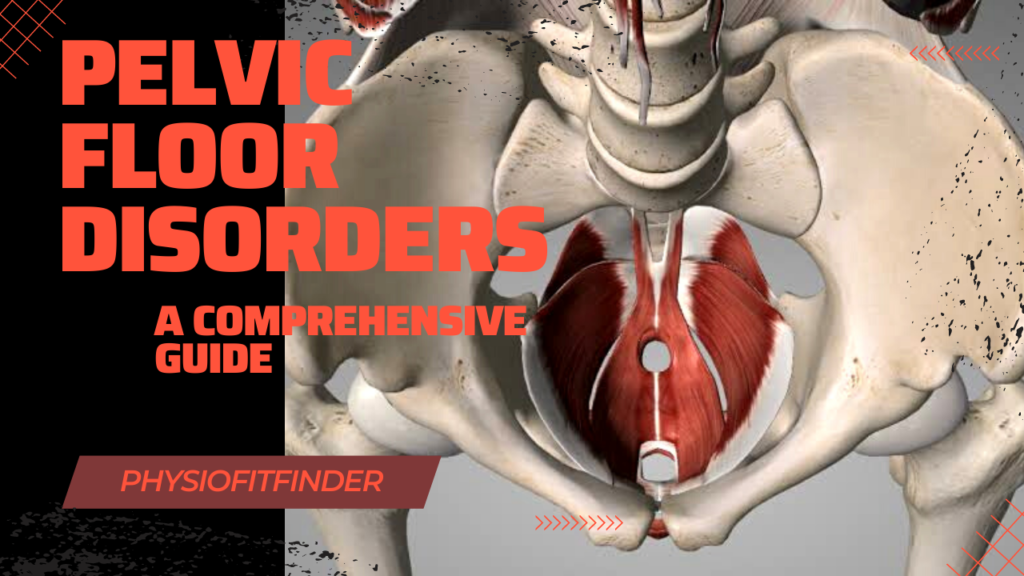Pelvic floor disorders (PFDs) are a common health issue affecting both men and women. They occur when the muscles, ligaments, and tissues supporting the pelvic organs become weakened or damaged, causing a variety of symptoms such as incontinence, pelvic pain, and sexual dysfunction.
PFDs can have a significant impact on a person’s quality of life, but physiotherapy can play an important role in managing these conditions.
In this article, we will discuss about pelvic floor muscles, different types of PFDs, the causes and symptoms of PFDs, and how physiotherapy can help in managing PFDs.
Pelvic Floor Muscles
The pelvic floor muscles are a group of muscles located at the bottom of the pelvis that support the pelvic organs, including the bladder, uterus, and rectum. These muscles play a vital role in controlling bladder and bowel function, sexual function, and overall pelvic stability. There are several individual pelvic floor muscles, each with their own specific functions.
Pubococcygeus (PC) Muscle: The PC muscle is the most well-known and commonly exercised pelvic floor muscle. It extends from the pubic bone to the coccyx and is responsible for controlling urine flow and supporting the pelvic organs. It also plays a role in sexual function by helping to control the timing of orgasm and increasing the intensity of sexual pleasure.
Iliococcygeus Muscle: The iliococcygeus muscle is located above the PC muscle and is responsible for supporting the pelvic organs and controlling the opening and closing of the urethra and anus.
Coccygeus Muscle: The coccygeus muscle is located at the back of the pelvic floor and is responsible for stabilizing the coccyx (tailbone) and supporting the pelvic organs.
Causes and Symptoms of PFDs
Pelvic Floor Disorders can be caused by a variety of factors, including childbirth, aging, surgery, obesity, chronic coughing or sneezing, and genetic factors. Women are more likely to develop PFDs than men, but men can also experience these conditions.
The symptoms of PFDs can vary depending on the type of disorder, but common symptoms include:
- Urinary incontinence (leaking urine)
- Urgency or frequency of urination
- Constipation or difficulty passing stools
- Pelvic pain or discomfort
- Pain during intercourse
- Pain in the lower back or hips
- Bulging or protrusion in the vagina or rectum
Types of Pelvic Floor Disorders
There are several types of PFDs, including:
Urinary Incontinence: This occurs when a person leaks urine involuntarily, usually due to weakened or damaged pelvic floor muscles. There are two types of urinary incontinence:
- Stress incontinence: which occurs when there is pressure on the bladder.
- Urge incontinence: which is caused by a sudden urge to urinate.
Pelvic Organ Prolapse: This occurs when the muscles and tissues supporting the pelvic organs weaken, causing one or more of the organs (such as the bladder, uterus, or rectum) to sag or protrude into the vaginal canal or rectum.
Chronic Pelvic Pain: This is pain that persists for six months or more in the pelvic area and is often associated with PFDs.
Sexual Dysfunction: This can include pain during intercourse, difficulty achieving or maintaining an erection, or decreased sexual desire.
How Physiotherapy Can Help
Physiotherapy can play an important role in managing PFDs. A physiotherapist who specializes in pelvic health can provide a comprehensive assessment of the pelvic floor muscles and develop a tailored treatment plan to address the specific needs of the patient.
Here are some ways that physiotherapy can help manage PFDs:
Pelvic Floor Muscle Exercises: These exercises, also known as Kegels, involve contracting and relaxing the pelvic floor muscles. Strengthening these muscles can help improve urinary incontinence, pelvic organ prolapse, and sexual dysfunction.
Manual Therapy: A physiotherapist may use manual therapy techniques such as massage or stretching to help relax tight or painful muscles in the pelvic region.
Biofeedback: Biofeedback uses technology to measure muscle activity and provide visual or auditory feedback to the patient. This can help the patient learn to control and strengthen their pelvic floor muscles.
Electrical Stimulation: Electrical stimulation involves using electrical current at various frequencies to stimulate the pelvic floor muscles. This can help improve muscle strength and control.
Bladder and Bowel Retraining: A physiotherapist can provide guidance on how to retrain the bladder and bowel to improve their function and reduce symptoms such as urinary urgency or constipation.
Education: A physiotherapist can provide education on proper posture, breathing techniques, and other lifestyle
CONCLUSION
In conclusion, Physiotherapy, can improve symptoms and quality of life for people with pelvic floor disorders. With proper treatment and management, many people with PFDs can experience significant improvements in symptoms and overall quality of life.
Awareness and education about pelvic floor health is crucial in promoting early detection and effective management of these conditions. However, it’s important to seek out a qualified physiotherapist, to develop an individualized treatment plan that meets your specific needs and goals

A very beneficial article for those patients who are suffering from Pelvic floor disorders ….But it’s important to seek a Qualified Physio for the purpose.